1999 TOYOTA TACOMA light
[x] Cancel search: lightPage 83 of 247
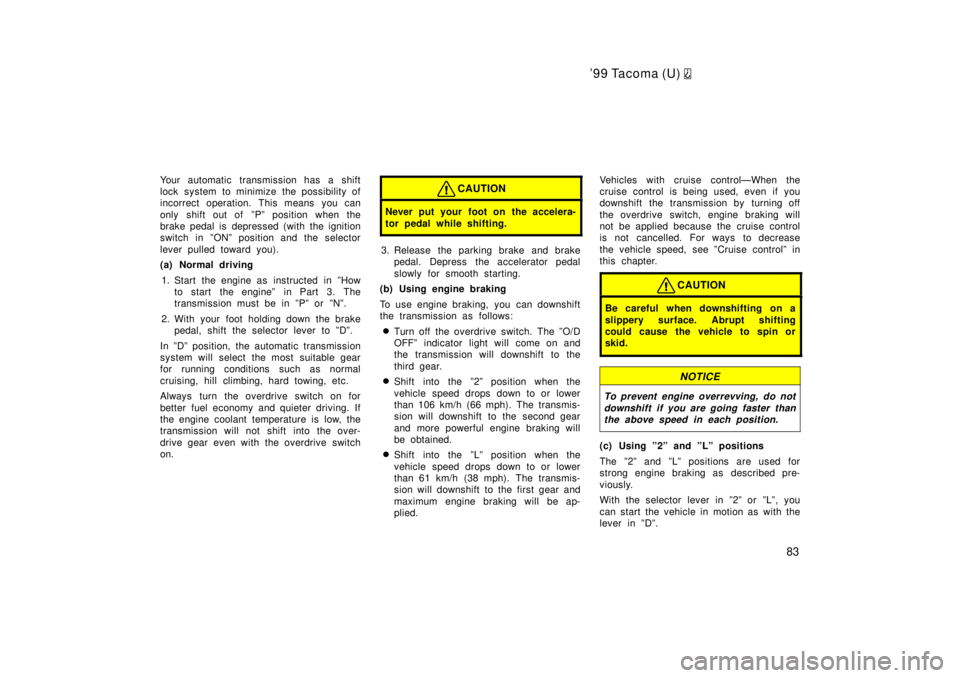
'99 Tacoma (U)
83
Your automatic transmission has a shift
lock system to minimize the possibility of
incorrect operation. This means you can
only shift out of ºPº position when the
brake pedal is depressed (with the ignition
switch in ºONº position and the selector
lever pulled toward you).
(a) Normal driving
1. Start the engine as instructed in ºHow to start the engineº in Part 3. The
transmission must be in ºPº or ºNº.
2. With your foot holding down the brake pedal, shift the selector lever to ºDº.
In ºDº position, the automatic transmission
system will select the most suitable gear
for running conditions such as normal
cruising, hill climbing, hard towing, etc.
Always turn the overdrive switch on for
better fuel economy and quieter driving. If
the engine coolant temperature is low, the
transmission will not shift into the over-
drive gear even with the overdrive switch on.
CAUTION
Never put your foot on the accelera-
tor pedal while shifting.
3. Release the parking brake and brake pedal. Depress the accelerator pedal
slowly for smooth starting.
(b) Using engine braking
To use engine braking, you can downshift
the transmission as follows:
� Turn off the overdrive switch. The ºO/D
OFFº indicator light will come on and
the transmission will downshift to the
third gear.
� Shift into the º2º position when the
vehicle speed drops down to or lower
than 106 km/h (66 mph). The transmis-
sion will downshift to the second gear
and more powerful engine braking will
be obtained.
� Shift into the ºLº position when the
vehicle speed drops down to or lower
than 61 km/h (38 mph). The transmis-
sion will downshift to the first gear and
maximum engine braking will be ap-
plied. Vehicles with cruise controlÐWhen the
cruise control is being used, even if you
downshift the transmission by turning off
the overdrive switch, engine braking will
not be applied because the cruise control
is not cancelled. For ways to decrease
the vehicle speed, see ºCruise controlº in
this chapter.
CAUTION
Be careful when downshifting on a
slippery surface. Abrupt shifting
could cause the vehicle to spin or
skid.
NOTICE
To prevent engine overrevving, do not
downshift if you are going faster thanthe above speed in each position.
(c) Using º2º and ºLº positions
The º2º and ºLº positions are used for
strong engine braking as described pre-
viously.
With the selector lever in º2º or ºLº, you
can start the vehicle in motion as with the
lever in ºDº.
Page 86 of 247

'99 Tacoma (U)
86
Shift while pulling the
selector lever toward you
With the brake pedal depressed,
shift while pulling the selector
lever toward you. (The ignition
switch must be in ºONº position.) Parking, engine starting
and key removal position
Reverse position
Neutral position
Normal driving position
Position for engine braking
Position for stronger engine
braking than that in º2º
position
Shift normally Driving pattern selector button
For selecting a driving pattern suited to
existing driving conditions
Overdrive switch
For selecting either a three- speed or
four- speed transmission ºOFFº position
(Shifting into
overdrive not
possible)
ºONº position
(Shifting into
overdrive
possible) ºO/D OFFº indicator
light
Shows the overdrive
switch is in ºOFFº
position
ºNORMALº
(Normal) mode
for general
driving conditions
ºPOWERº
(Power) mode
for powerful
accelerationPOWER mode indicator
light on the instrument
panel shows the driving
pattern selector button
is in the ºPOWERº mode.
Vehicles with cruise controlÐWhen the cruise control is being used, eve n if you downshift the transmission by turning off the overdrive
switch, engine braking will not be applied because the cruise cont rol is not cancelled. For ways to decrease the vehicle speed, see
ºCruise controlº in this chapter. Automatic transmission
(electronically controlled typeÐtwo- wheel drive models except Pre R
unner)
Page 87 of 247
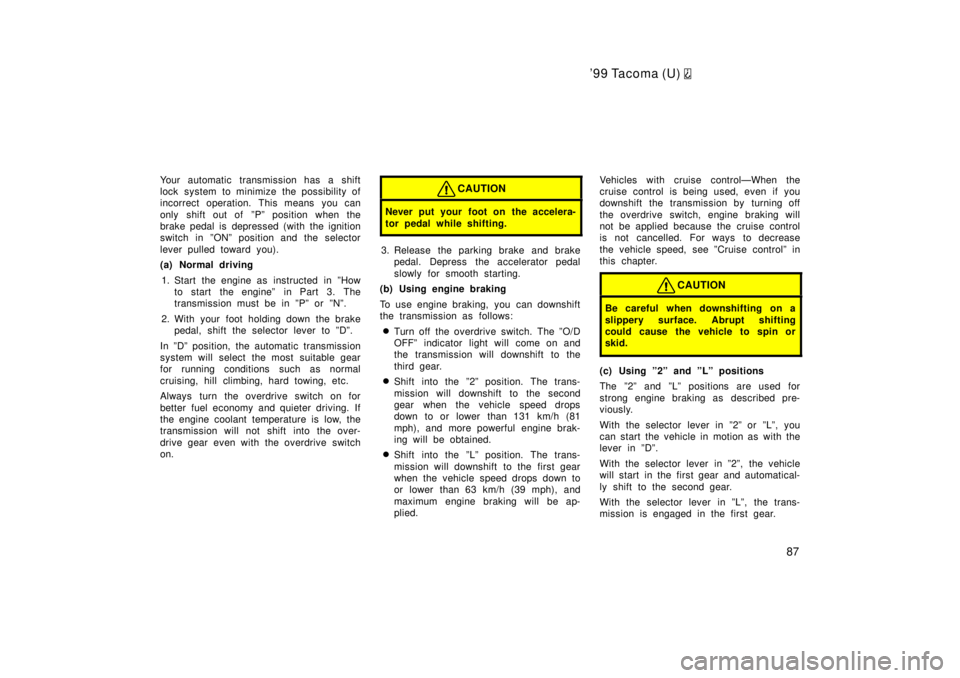
'99 Tacoma (U)
87
Your automatic transmission has a shift
lock system to minimize the possibility of
incorrect operation. This means you can
only shift out of ºPº position when the
brake pedal is depressed (with the ignition
switch in ºONº position and the selector
lever pulled toward you).
(a) Normal driving
1. Start the engine as instructed in ºHow to start the engineº in Part 3. The
transmission must be in ºPº or ºNº.
2. With your foot holding down the brake pedal, shift the selector lever to ºDº.
In ºDº position, the automatic transmission
system will select the most suitable gear
for running conditions such as normal
cruising, hill climbing, hard towing, etc.
Always turn the overdrive switch on for
better fuel economy and quieter driving. If
the engine coolant temperature is low, the
transmission will not shift into the over-
drive gear even with the overdrive switch on.
CAUTION
Never put your foot on the accelera-
tor pedal while shifting.
3. Release the parking brake and brake pedal. Depress the accelerator pedal
slowly for smooth starting.
(b) Using engine braking
To use engine braking, you can downshift
the transmission as follows:
� Turn off the overdrive switch. The ºO/D
OFFº indicator light will come on and
the transmission will downshift to the
third gear.
� Shift into the º2º position. The trans-
mission will downshift to the second
gear when the vehicle speed drops
down to or lower than 131 km/h (81
mph), and more powerful engine brak-
ing will be obtained.
� Shift into the ºLº position. The trans-
mission will downshift to the first gear
when the vehicle speed drops down to
or lower than 63 km/h (39 mph), and
maximum engine braking will be ap-
plied. Vehicles with cruise controlÐWhen the
cruise control is being used, even if you
downshift the transmission by turning off
the overdrive switch, engine braking will
not be applied because the cruise control
is not cancelled. For ways to decrease
the vehicle speed, see ºCruise controlº in
this chapter.
CAUTION
Be careful when downshifting on a
slippery surface. Abrupt shifting
could cause the vehicle to spin or
skid.
(c) Using º2º and ºLº positions
The º2º and ºLº positions are used for
strong engine braking as described pre-
viously.
With the selector lever in º2º or ºLº, you
can start the vehicle in motion as with the
lever in ºDº.
With the selector lever in º2º, the vehicle
will start in the first gear and automatical-
ly shift to the second gear.
With the selector lever in ºLº, the trans-
mission is engaged in the first gear.
Page 88 of 247
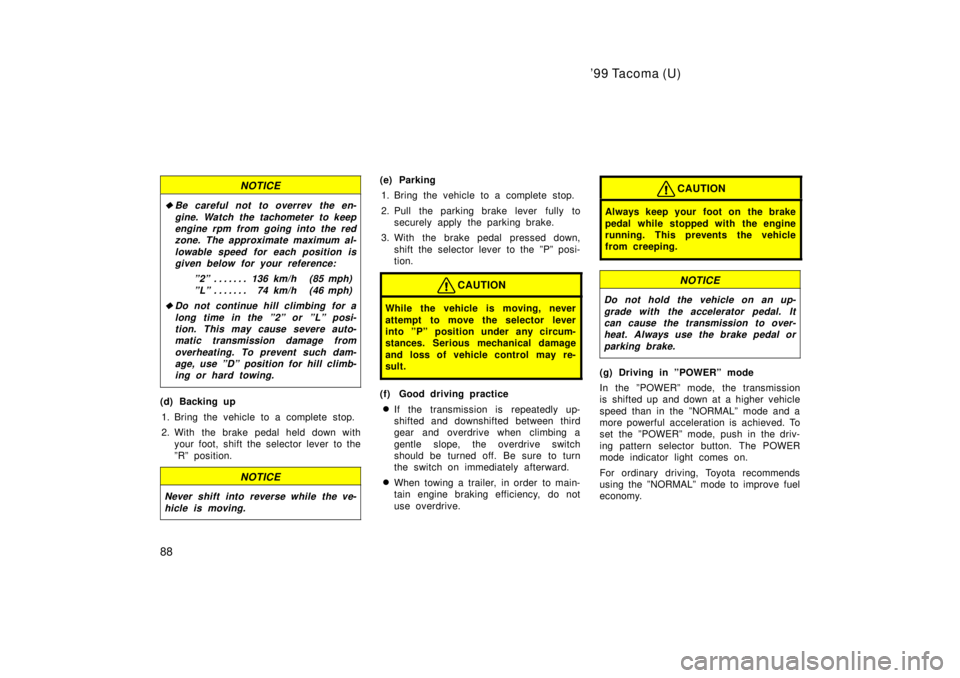
'99 Tacoma (U)
88
NOTICE
�Be careful not to overrev the en- gine. Watch the tachometer to keepengine rpm from going into the red zone. The approximate maximum al-
lowable speed for each position isgiven below for your reference:
º2º 136 km/h (85 mph). . . . . . .
ºLº 74 km/h (46 mph) . . . . . . .
�Do not continue hill climbing for a
long time in the º2º or ºLº posi-tion. This may cause severe auto- matic transmission damage from
overheating. To prevent such dam-age, use ºDº position for hill climb-
ing or hard towing.
(d) Backing up
1. Bring the vehicle to a complete stop.
2. With the brake pedal held down with your foot, shift the selector lever to the
ºRº position.
NOTICE
Never shift into reverse while the ve-
hicle is moving.
(e) Parking
1. Bring the vehicle to a complete stop.
2. Pull the parking brake lever fully to securely apply the parking brake.
3. With the brake pedal pressed down, shift the selector lever to the ºPº posi-
tion.
CAUTION
While the vehicle is moving, never
attempt to move the selector lever
into ºPº position under any circum-
stances. Serious mechanical damage
and loss of vehicle control may re-
sult.
(f) Good driving practice
� If the transmission is repeatedly up-
shifted and downshifted between third
gear and overdrive when climbing a
gentle slope, the overdrive switch
should be turned off. Be sure to turn
the switch on immediately afterward.
� When towing a trailer, in order to main-
tain engine braking efficiency, do not
use overdrive.
CAUTION
Always keep your foot on the brake
pedal while stopped with the engine
running. This prevents the vehicle
from creeping.
NOTICE
Do not hold the vehicle on an up-
grade with the accelerator pedal. Itcan cause the transmission to over- heat. Always use the brake pedal or
parking brake.
(g) Driving in ºPOWERº mode
In the ºPOWERº mode, the transmission
is shifted up and down at a higher vehicle
speed than in the ºNORMALº mode and a
more powerful acceleration is achieved. To
set the ºPOWERº mode, push in the driv-
ing pattern selector button. The POWER
mode indicator light comes on.
For ordinary driving, Toyota recommends
using the ºNORMALº mode to improve fuel
economy.
Page 90 of 247

'99 Tacoma (U)
90
Parking, engine starting
and key removal position
Reverse position
Neutral position
Normal driving position
Position for engine braking
Position for stronger engine
braking than that in º2º
position
With the brake pedal depressed,
shift while holding the lock
release button in. (The ignition
switch must be in ºONº position.)
Shift while holding the lock
release button in Driving pattern selector button
For selecting a driving pattern suited to
existing driving conditions
Overdrive switch
For selecting either a three- speed or
four- speed transmission
Off position
(Shifting into
overdrive not
possible) On position
(Shifting into
overdrive
possible)
Lock release button
To prevent misshifting
ºO/D OFFº indicator
light
Shows the overdrive
switch is in off
position
ºNORMALº
(Normal) mode
for general
driving conditions
ºPOWERº
(Power) mode
for powerful
accelerationPOWER mode indicator
light on the instrument
panel shows the driving
pattern selector button
is in the ºPOWERº mode.
Shift normally
Vehicles with cruise controlÐWhen the cruise control is being used, eve n if you downshift the transmission by turning off the overdrive
switch, engine braking will not be applied because the cruise cont rol is not cancelled. For ways to decrease the vehicle speed, see
ºCruise controlº in this chapter. Automatic transmission
(electronically controlled typeÐfour- wheel drive models and Pre Runner
)
Page 91 of 247
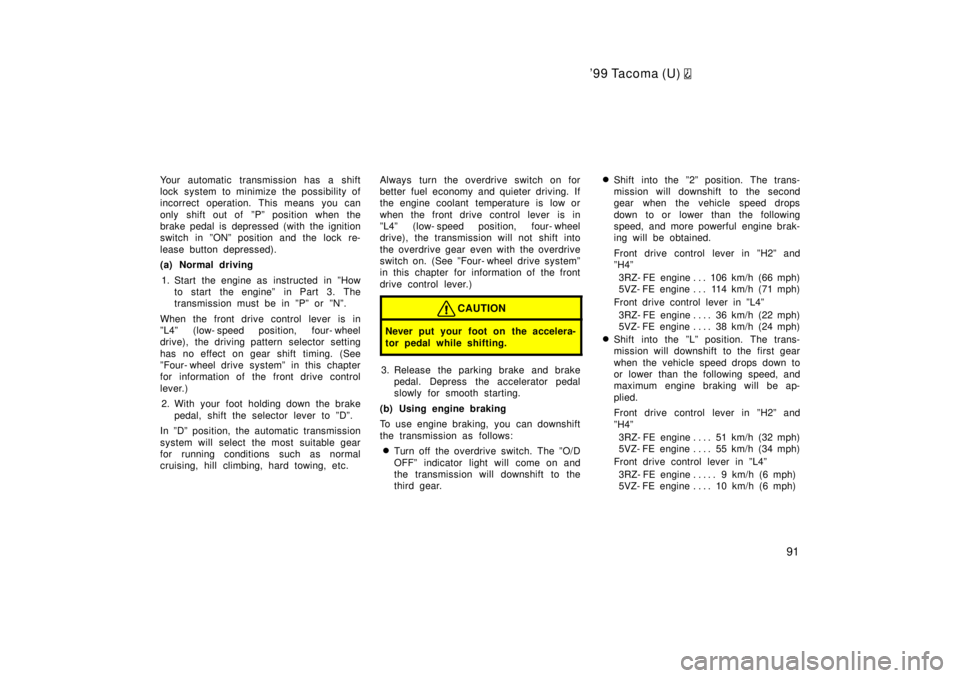
'99 Tacoma (U)
91
Your automatic transmission has a shift
lock system to minimize the possibility of
incorrect operation. This means you can
only shift out of ºPº position when the
brake pedal is depressed (with the ignition
switch in ºONº position and the lock re-
lease button depressed).
(a) Normal driving
1. Start the engine as instructed in ºHow to start the engineº in Part 3. The
transmission must be in ºPº or ºNº.
When the front drive control lever is in
ºL4º (low- speed position, four- wheel
drive), the driving pattern selector setting
has no effect on gear shift timing. (See
ºFour- wheel drive systemº in this chapter
for information of the front drive control
lever.) 2. With your foot holding down the brake pedal, shift the selector lever to ºDº.
In ºDº position, the automatic transmission
system will select the most suitable gear
for running conditions such as normal
cruising, hill climbing, hard towing, etc. Always turn the overdrive switch on for
better fuel economy and quieter driving. If
the engine coolant temperature is low or
when the front drive control lever is in
ºL4º (low- speed position, four- wheel
drive), the transmission will not shift into
the overdrive gear even with the overdrive
switch on. (See ºFour- wheel drive systemº
in this chapter for information of the front
drive control lever.)
CAUTION
Never put your foot on the accelera-
tor pedal while shifting.
3. Release the parking brake and brake
pedal. Depress the accelerator pedal
slowly for smooth starting.
(b) Using engine braking
To use engine braking, you can downshift
the transmission as follows: � Turn off the overdrive switch. The ºO/D
OFFº indicator light will come on and
the transmission will downshift to the
third gear. �
Shift into the º2º position. The trans-
mission will downshift to the second
gear when the vehicle speed drops
down to or lower than the following
speed, and more powerful engine brak-
ing will be obtained.
Front drive control lever in ºH2º and
ºH4º
3RZ- FE engine 106 km/h (66 mph) . . .
5VZ- FE engine 114 km/h (71 mph) . . .
Front drive control lever in ºL4º 3RZ- FE engine 36 km/h (22 mph) . . . .
5VZ- FE engine 38 km/h (24 mph) . . . .
� Shift into the ºLº position. The trans-
mission will downshift to the first gear
when the vehicle speed drops down to
or lower than the following speed, and
maximum engine braking will be ap-
plied.
Front drive control lever in ºH2º and
ºH4º
3RZ- FE engine 51 km/h (32 mph) . . . .
5VZ- FE engine 55 km/h (34 mph) . . . .
Front drive control lever in ºL4º 3RZ- FE engine 9 km/h (6 mph) . . . . .
5VZ- FE engine 10 km/h (6 mph) . . . .
Page 93 of 247
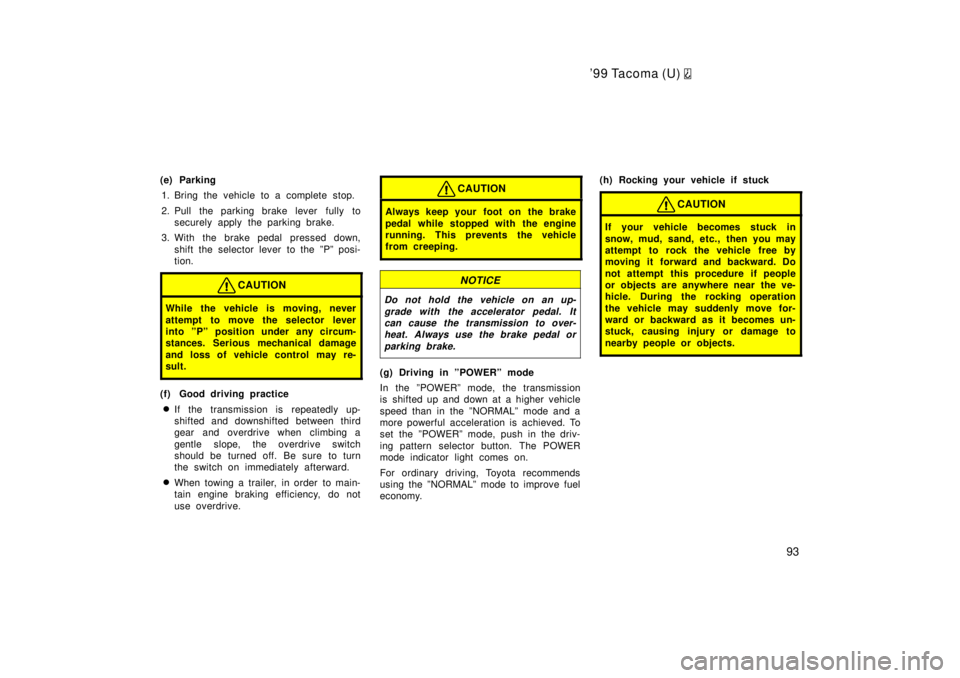
'99 Tacoma (U)
93
(e) Parking
1. Bring the vehicle to a complete stop.
2. Pull the parking brake lever fully to securely apply the parking brake.
3. With the brake pedal pressed down, shift the selector lever to the ºPº posi-
tion.
CAUTION
While the vehicle is moving, never
attempt to move the selector lever
into ºPº position under any circum-
stances. Serious mechanical damage
and loss of vehicle control may re-
sult.
(f) Good driving practice
� If the transmission is repeatedly up-
shifted and downshifted between third
gear and overdrive when climbing a
gentle slope, the overdrive switch
should be turned off. Be sure to turn
the switch on immediately afterward.
� When towing a trailer, in order to main-
tain engine braking efficiency, do not
use overdrive.
CAUTION
Always keep your foot on the brake
pedal while stopped with the engine
running. This prevents the vehicle
from creeping.
NOTICE
Do not hold the vehicle on an up-
grade with the accelerator pedal. Itcan cause the transmission to over- heat. Always use the brake pedal or
parking brake.
(g) Driving in ºPOWERº mode
In the ºPOWERº mode, the transmission
is shifted up and down at a higher vehicle
speed than in the ºNORMALº mode and a
more powerful acceleration is achieved. To
set the ºPOWERº mode, push in the driv-
ing pattern selector button. The POWER
mode indicator light comes on.
For ordinary driving, Toyota recommends
using the ºNORMALº mode to improve fuel
economy. (h) Rocking your vehicle if stuck
CAUTION
If your vehicle becomes stuck in
snow, mud, sand, etc., then you may
attempt to rock the vehicle free by
moving it forward and backward. Do
not attempt this procedure if people
or objects are anywhere near the ve-
hicle. During the rocking operation
the vehicle may suddenly move for-
ward or backward as it becomes un-
stuck, causing injury or damage to
nearby people or objects.
Page 96 of 247
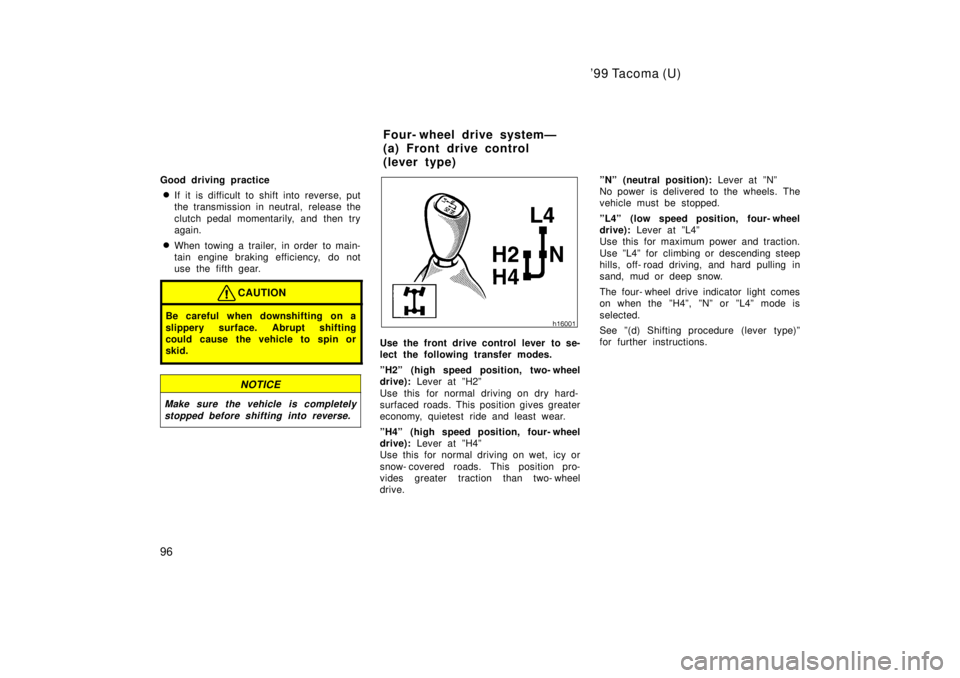
'99 Tacoma (U)
96
Good driving practice
� If it is difficult to shift into reverse, put
the transmission in neutral, release the
clutch pedal momentarily, and then try
again.
� When towing a trailer, in order to main-
tain engine braking efficiency, do not
use the fifth gear.
CAUTION
Be careful when downshifting on a
slippery surface. Abrupt shifting
could cause the vehicle to spin or
skid.
NOTICE
Make sure the vehicle is completely
stopped before shifting into reverse.
Use the front drive control lever to se-
lect the following transfer modes.
ºH2º (high speed position, two- wheel
drive): Lever at ºH2º
Use this for normal driving on dry hard-
surfaced roads. This position gives greater
economy, quietest ride and least wear.
ºH4º (high speed position, four- wheel
drive): Lever at ºH4º
Use this for normal driving on wet, icy or
snow- covered roads. This position pro-
vides greater traction than two- wheel
drive. ºNº (neutral position):
Lever at ºNº
No power is delivered to the wheels. The
vehicle must be stopped.
ºL4º (low speed position, four- wheel
drive): Lever at ºL4º
Use this for maximum power and traction.
Use ºL4º for climbing or descending steep
hills, off- road driving, and hard pulling in
sand, mud or deep snow.
The four- wheel drive indicator light comes
on when the ºH4º, ºNº or ºL4º mode is
selected.
See º(d) Shifting procedure (lever type)º
for further instructions.
Four- wheel drive systemÐ
(a) Front drive control
(lever type)